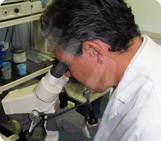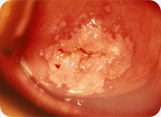
A colposcopy is a procedure to examine the cervix using a lighted binocular microscope which allows a magnified and illuminated view of the cervix. This procedure is used to detect lesions that are generally invisible to the naked eye and which could, if ignored, potentially develop into cervical cancer.
The procedure is painless and requires the insertion of a speculum that keeps the vagina open to expose the cervix.

Once the cervix, is in view, the doctor applies two solutions, which facilitate the observation and identification of any possible precancerous lesions:
- a solution of acetic acid, a type of vinegar which “whitens” any suspect areas,
- a solution of “Lugol” based on iodine which allows the limits of the suspect zones to be identified
Neither solution is painful nor allergenic.

Upon completion of the procedure and depending on what was observed, one or more biopsies may be taken in order to analyze tissue taken from the zones considered most suspect.
Example of a colposcopy image. Note the presence of some abnormal white zones.
The tissue samples are then placed in a preserving vial which fixes the tissue cells ready for analysis at the histopathology laboratory. Results are generally returned within 7 days and patients may then require a further consultation with the doctor in order to clarify the results and where necessary decide upon an appropriate treatment plan.
Biopsies are not generally painful procedures but patients may experience light bleeding for some time and so should be made aware.
A colposcopy also allows an examination for lesions on: the vagina, the vulva, the anus, or the perineum.
WHEN SHOULD ONE PERFORM A COLPOSCOPY?
A colposcopy should be performed when:
- Abnormal smear test results suggest the presence of a high grade lesion, or a low grade lesion or of type ASC-USwith an HPV control that tests positive for the high risk viruses (potentially cancer causing).
- Abnormalities in the vulva suggest an HPV (Human Papillomavirus) infection.
- An HPV (Human Papillomavirus) infection is persistent (HPV test is persistently positive).
- A cervix appears abnormal or suspect to the clinician.
- During treatment wherethe surgeon treats any lesions with the aid of the colposcope
- During post treatment monitoring so as to verify absence of any remaining lesions.


